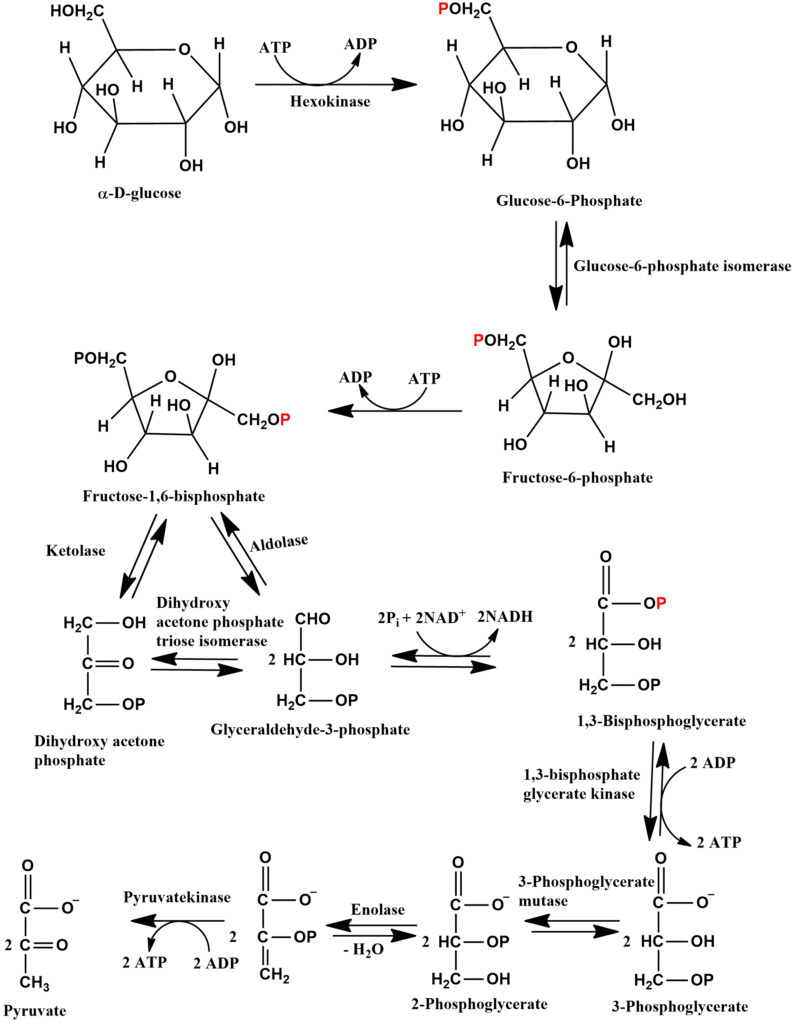Table of Contents
ToggleThe metabolic pathway which converts glucose (C6H12O6) into pyruvic acid (CH3COCOOH) is known as glycolysis cycle. The word glycolysis is derived from the Greek word ‘Glykys’ meaning ‘sweet’ and ‘lysis’ meaning ‘splitting’. So, in glycolysis, a molecule of glucose is degraded in a series of enzyme-catalyzed reactions to yield two molecules of pyruvate.
Glycolysis Cycle
During the sequential reactions of glycolysis, some of the energy released from glucose is conserved in the form of ATP. It was the first metabolic pathway to be elucidated and is probably the best understood. The glycolysis cycle was first discovered by Gustav Embden, Otto Meyerhof, and Jakub Karol Parnos, so it is also known as the EMP pathway.
Glycolysis is an almost universal central pathway of glucose catabolism. The largest flux of carbon occurs in most cells through this pathway. In certain types of mammalian tissues and cells (erythrocytes, renal medulla, brain, and sperm) glucose is the sole or major source of energy through glycolysis. Plant tissues that are modified for the storage of starch and plants adapted for growth in water-inundated areas derive most of their energies from the glycolysis cycle.
Steps Involved in Glycolysis Cycle
The breakdown of the six-carbon glucose into two molecules of three-carbon pyruvate occurs in ten steps, the first five of which constitute the preparatory phase and the last five constitute the pay-off phase. The energy gain comes in the pay-off phase of glycolysis. The glycolysis cycle occurs as follows:
Step 1: In the initial step glucose is phosphorylated at the hydroxyl group on C-6 to obtain D-glucose-6-phosphate by hexokinase enzyme. In this step, energy is utilized.
Step 2: Thus, obtained D-glucose-6-phosphate is converted into D-fructose-6-phosphate by glucose-6-phosphate isomerase enzyme.
Step 3: In the third step, D-fructose-6-phosphate is converted into D-fructose-1,6-bisphosphate by the catalytic action of fructose-6-phosphate kinase. This step also utilizes energy in the form of ATP.
Step 4: In this step, D-fructose-1,6-bisphosphate is split catalytically into three-membered dihydroxyacetone phosphate and glyceraldehyde-3-phosphate by the action of ketolase and aldolase enzymes respectively.
Step 5: Thus, obtained dihydroxyacetone phosphate is converted reversibly into a second molecule of glyceraldehyde-3-phosphate by dihydroxy acetone phosphate triose isomerase enzyme.
Step 6: Each molecule of glyceraldehyde-3-phosphate is oxidized and phosphorylated by inorganic phosphate to form 1,3-bisphosphoglycerate. In this step, two molecules of NAD+ are converted into two molecules of NADH.
Step 7: In this step, 1,3-bisphosphoglycerate is dephosphorylated into 3-phosphoglycerate by 1,3-bisphosphate glyceratekinase enzyme.
Step 8: 3-phosphoglycerate is isomerized catalytically to 2-phosphoglycerate by enzyme 3-phosphoglyceratemutase.
Step 9: In this step, 2-phosphoglycerate is reversibly converted to phosphoenol pyruvate by enolase enzyme with the release of water.
Step 10: With the release of two molecules of ATP phosphoenol pyruvate is catalytically converted into pyruvate by pyruvate kinase enzyme.

ATP formation in the Glycolysis cycle
During the glycolysis cycle, some of the energy of the glucose molecule is conserved in the form of ATP, while much remains in the product, pyruvate. The overall equation for glycolysis is as follows:

So, the total ATP produced during glycolysis cycle = 8 ATP ( 1 NADH = 3 ATP)
Published by: Siddha Raj Upadhyaya
Glycolysis cycle video
FAQs/MCQs:
How many ATP are produced in glycolysis?
8 ATP molecules are produced in glycolysis.
How many NADH are produced by glycolysis?
2 NADH molecules are produced by glycolysis






